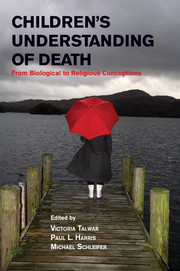Book contents
- Frontmatter
- Contents
- List of Figures and Table
- List of Contributors
- Preface and Acknowledgments
- 1 Death, Ancestors, and the Living Dead: Learning without Teaching in Madagascar
- 2 Death in Spain, Madagascar, and Beyond
- 3 Ambivalent Teaching and Painful Learning: Mastering the Facts of Life (?)
- 4 Death in the Lives of Children
- 5 Talking to Children about Death in Educational Settings
- 6 Responsible Believing
- 7 Thoughts and Feelings: Children and William James Have It Right!
- 8 How the Law Constructs Its Understanding of Death
- Index
- References
7 - Thoughts and Feelings: Children and William James Have It Right!
Published online by Cambridge University Press: 03 May 2011
- Frontmatter
- Contents
- List of Figures and Table
- List of Contributors
- Preface and Acknowledgments
- 1 Death, Ancestors, and the Living Dead: Learning without Teaching in Madagascar
- 2 Death in Spain, Madagascar, and Beyond
- 3 Ambivalent Teaching and Painful Learning: Mastering the Facts of Life (?)
- 4 Death in the Lives of Children
- 5 Talking to Children about Death in Educational Settings
- 6 Responsible Believing
- 7 Thoughts and Feelings: Children and William James Have It Right!
- 8 How the Law Constructs Its Understanding of Death
- Index
- References
Summary
The “Thought” which we have relied upon in our account is not the brain, closely as it seems connected with it.
William James, Principles of Psychology, p. 346I do not fully understand how we come to our unshakeable belief that thinking exists as a special kind of immaterial process alongside of the material processes of the world.
William James, Principles of Psychology, p. 570As we have seen (see Chapters 1 and 2 by Harris and Astuti in this volume), children readily accept both the supernatural and the biological conceptions of death. This is because children are not “materialists.” Their experiences have led them to their own “theory” of mind that is incompatible with the idea that physical matter is the only or fundamental reality. Children believe that mental events exist, are real, and are different from physical or material ones. In this chapter, I shall argue that children have it right.
One hundred years ago, psychologist-philosopher William James (1842–1910) defended the same nonmaterialist view as is held by children. As we have seen (Chapter 6 in this volume), James maintained that it was reasonable to accept beliefs (including religious ones) even where the evidence was not sufficient. James also provided “evidence and argument” (Myers, 1981, p. xxii) for the nonmaterialist position.
- Type
- Chapter
- Information
- Children's Understanding of DeathFrom Biological to Religious Conceptions, pp. 133 - 155Publisher: Cambridge University PressPrint publication year: 2011



